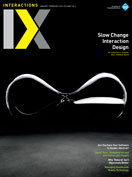Authors:
Ron Wakkary, Erik Stolterman
Interactions magazine is celebrating: We are 20 years old! The first issue was published in January 1994. Beginning as a quarterly and then moving to a bimonthly publication schedule in 1996 means 116 issues in total! That's more than 1,900 articles over the years. As editors-in-chief, we are also celebrating the end of our first term and the start of our second. We are happy to have been assigned a second term, and we will do our best to continue to improve Interactions.
In preparation for the next 20 years, we have been busy these past months working on a redesign and rebranding for the magazine, led by Luke Hayman and his team at Pentagram. You are holding in your hands the first issue with our new layout, graphic design, and brand.
The redesign that Luke and his team executed for Interactions is tailored to allow a better reading experience (we even altered a typeface to create our very own letter "j"!). Particular attention was given to how visual structure and white spaces can draw in the reader. We now provide key insights at the beginning of each feature article to help readers quickly grasp the authors' aims. This was also an opportunity to rethink the layout for strongly visual departments like Demo Hour and Day in the Lab, and to add two new departments that we debut in this issue: How Was This Made? and What Are You Reading?
We must also mention our new brand and logo. This was the most challenging and thrilling decision to make. Pentagram offered us many great options, from incremental changes to what you now see. We felt that the best way to honor the foundation of the past 20 years of Interactions was to make a radical change that would hold up for the next 20 years and beyond.
We leave the full run-through of the new design in the more capable hands of Luke, who explains his process in a special guest column on page 7. We are grateful to Luke and his colleagues for coming up with such an extraordinary design for us.
We are also grateful for the support we have received from ACM that has made it possible for us to succeed in this redesign process. We especially want to thank Scott Delman, Diane Crawford, and John Stanik at ACM. We also want to send a big thanks to Andrij Borys and Brian Greenberg at Andrij Borys Associates, the magazine's longtime art department, who have taken the redesign and shaped it into this issue.
Improving a magazine's design is one thing; improving ourselves when it comes to health, fitness, and habits is potentially far more complex. Changes in such areas take time, effort, and determination. We are surrounded by artifacts, systems, and designs that promise to help us better our lives and ourselves over time. At the same time, our field tends to focus on solving existing (and urgent or immediate) problems by devising a once-and-for-all solution. But what about designing technology to help us change habits that may take months, years, or decades to shift? In this issue's cover story, authors Martin Siegel and Jordan Beck examine this problem and introduce the notion of slow change interaction design.
We are also happy to present a special topic titled "Designing for and with Vulnerable People," edited by John Vines and colleagues. Resulting from a CHI 2013 workshop, this special topic thoughtfully addresses the practices of research with this focus.
We are pleased to announce a new forum, The Business of UX, edited by Daniel Rosenberg. For some time we've wanted a forum that covers aspects of our field from a business perspective. Daniel's debut article challenges us with key topics to tackle at the intersection of business and UX.
We also want to take the opportunity to thank Hugh Dubberly, a core and invaluable member of the Interactions team as the editor (and often co-author) of the On Modeling forum. Thanks, Hugh, for your many years of service to this magazine!
Finally, remember that we are always looking forward to your submissions to Interactions. Please contact us if you're interested in writing for the magazine.
Ron Wakkary and Erik Stolterman, [email protected]
COPYRIGHT HELD BY AUTHORS
The Digital Library is published by the Association for Computing Machinery. Copyright © 2014 ACM, Inc.








Post Comment
No Comments Found